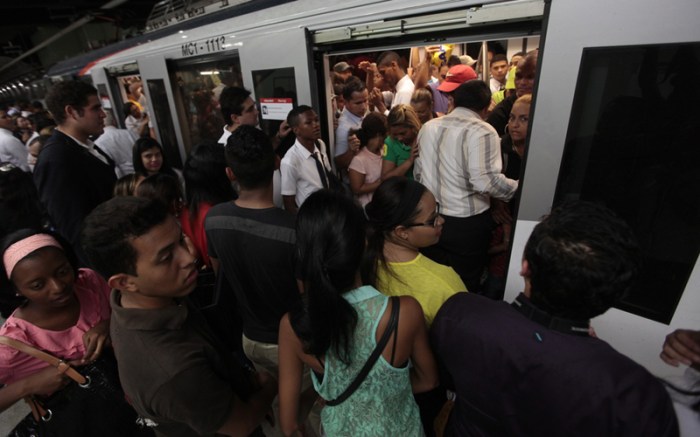Se viajaba mucho en tren. Embark on a captivating journey through the annals of train travel, where we delve into its rich history, technological advancements, cultural significance, and the challenges and opportunities that shape its future.
From its humble origins to its transformative role in the industrial revolution and beyond, train travel has left an indelible mark on our world.
Historical Context of Train Travel
Train travel has a rich and transformative history, shaping societies and economies worldwide. Its origins can be traced back to the early 19th century, with the invention of the steam locomotive.
The industrial revolution saw trains emerge as a vital mode of transportation, facilitating the movement of goods and people. They played a pivotal role in the growth of cities, connecting industrial centers and expanding trade networks.
Social and Cultural Impact
Beyond their economic significance, trains also had a profound social and cultural impact. They enabled mass tourism and leisure travel, allowing people to explore new destinations and experience diverse cultures.
Technological Advancements in Train Travel

Train travel has witnessed a remarkable evolution over the centuries, driven by groundbreaking technological advancements. From the advent of steam engines to the introduction of electric trains, these innovations have revolutionized the speed, efficiency, and comfort of train journeys.
Steam Engines
The invention of the steam engine in the 18th century marked a pivotal moment in train travel. Steam locomotives, powered by burning coal or wood, provided a reliable and efficient means of transportation. Their ability to generate immense power enabled trains to carry heavier loads and travel at faster speeds, opening up new possibilities for long-distance travel and trade.
Diesel Locomotives
In the early 20th century, diesel locomotives emerged as a more efficient and environmentally friendly alternative to steam engines. These locomotives utilized diesel fuel, which provided greater power and torque while emitting fewer pollutants. Diesel locomotives played a crucial role in modernizing train travel, allowing for faster and more reliable services.
Electric Trains
The advent of electric trains in the late 19th century introduced a new era of speed and efficiency. Electric trains draw power from an external source, eliminating the need for onboard fuel and reducing operating costs. They offer higher acceleration, smoother rides, and the ability to travel at even faster speeds.
Electric trains have become increasingly popular in recent decades, particularly in urban areas where they provide a cleaner and more sustainable mode of transportation.
Track Improvements
Alongside advancements in locomotives, improvements in track infrastructure have significantly enhanced train travel. The development of heavier and more durable rails, along with the use of ballast and sleepers, has allowed for faster and smoother train operations. Modern track systems incorporate advanced signaling systems, which ensure safe and efficient train movements, reducing delays and improving overall punctuality.
Safety Measures
Technological advancements have also played a vital role in enhancing the safety of train travel. The introduction of automatic train control systems, which monitor train speed and position, has significantly reduced the risk of collisions and derailments. Additionally, the use of crash-resistant materials and improved braking systems has further increased passenger safety.
Train Travel as a Form of Mass Transportation

Train travel has a long and storied history, dating back to the early 19th century. Today, trains remain an important form of transportation around the world, carrying billions of passengers each year.There are many advantages to train travel over other forms of transportation.
Trains are generally more affordable than flying, and they offer a more comfortable and convenient travel experience. Trains are also more environmentally friendly than cars, as they produce far less emissions.In addition to its many advantages, train travel also plays an important role in connecting urban and rural areas.
Trains can provide a vital link between communities that are not well-served by other forms of transportation. This can help to promote regional development and economic growth.
Volume of Train Travel Worldwide
According to the International Union of Railways (UIC), there were over 23 billion passenger journeys by train in 2019. This number is expected to grow in the coming years, as more and more people discover the advantages of train travel.
Advantages of Train Travel
There are many advantages to train travel over other forms of transportation. Some of the most notable advantages include:*
-*Cost
Train travel is generally more affordable than flying, especially for long distances.
-
-*Convenience
Trains offer a more convenient travel experience than cars. Passengers can relax and enjoy the scenery, or they can catch up on work or sleep.
-*Environmental friendliness
Trains are more environmentally friendly than cars, as they produce far less emissions.
Role of Train Travel in Connecting Urban and Rural Areas, Se viajaba mucho en tren.
Trains can play an important role in connecting urban and rural areas. In many parts of the world, trains are the only form of transportation that can reach remote communities. This can help to promote regional development and economic growth.For
Se viajaba mucho en tren. Los trenes eran el principal medio de transporte para largas distancias. Los ferrocarriles se expandieron rápidamente en el siglo XIX, lo que hizo que los viajes fueran más fáciles y asequibles. Para obtener más información sobre la historia del transporte ferroviario, consulte ftce social science 6 12 . El crecimiento de los ferrocarriles tuvo un profundo impacto en la sociedad, facilitando el movimiento de personas y mercancías y conectando comunidades distantes.
Se viajaba mucho en tren, lo que contribuyó al crecimiento económico y al intercambio cultural.
example, in China, the high-speed rail network has helped to connect remote villages to major cities. This has led to increased economic growth and improved quality of life for rural residents.
The Cultural Significance of Train Travel

Train travel has left an indelible mark on human culture. From its depiction in literature and art to its role in shaping our perceptions of time and space, trains have become cultural icons.Train journeys have been a source of inspiration for writers and artists for centuries.
The rhythmic clatter of wheels, the changing landscapes, and the encounters with fellow passengers have provided a rich backdrop for stories and paintings. In literature, trains have served as settings for mysteries, romances, and adventures. From Agatha Christie’s “Murder on the Orient Express” to J.K.
Rowling’s “Harry Potter” series, trains have played a pivotal role in shaping our literary imagination.Similarly, in art, trains have been immortalized in paintings, sculptures, and photographs. Impressionist painters such as Claude Monet and Pierre-Auguste Renoir captured the fleeting beauty of train stations and landscapes viewed from train windows.
The iconic “Whistler’s Mother” by James McNeill Whistler depicts a woman seated in a train carriage, her face obscured by steam.Beyond their literary and artistic significance, trains have also shaped our cultural perceptions of time and space. Before the advent of trains, travel was a slow and arduous process.
Trains revolutionized transportation, enabling people to travel vast distances in a matter of hours. This increased mobility had a profound impact on how we perceive time and distance.Trains also played a crucial role in the development of mass tourism. By making travel more accessible and affordable, trains opened up new possibilities for leisure and exploration.
Iconic train routes such as the Trans-Siberian Railway and the Orient Express became symbols of adventure and cultural exchange.
Challenges and Opportunities in Train Travel

Train travel has evolved significantly over the years, but it continues to face challenges in the modern era. One of the primary challenges is competition from air travel and road transportation. Air travel offers faster travel times, particularly for long distances, while road transportation provides greater flexibility and convenience for shorter journeys.
Despite these challenges, train travel presents numerous opportunities for adaptation and growth. High-speed rail networks, for example, can significantly reduce travel times and make train travel more competitive with air travel. Additionally, sustainable practices, such as the use of renewable energy sources and energy-efficient technologies, can make train travel more environmentally friendly and appealing to eco-conscious travelers.
Role of Government Policies and Investments
Government policies and investments play a crucial role in shaping the future of train travel. Governments can support the development of high-speed rail networks, invest in infrastructure upgrades, and provide incentives for sustainable practices. By doing so, they can make train travel more competitive, efficient, and environmentally friendly, ensuring its continued relevance in the transportation landscape.
General Inquiries: Se Viajaba Mucho En Tren.
What were the major technological advancements that shaped train travel?
The introduction of steam engines, diesel locomotives, and electric trains revolutionized train travel, enhancing speed, efficiency, and comfort.
How has train travel influenced our cultural perceptions?
Train travel has shaped our understanding of time, space, and mobility, inspiring countless works of literature, art, and music.